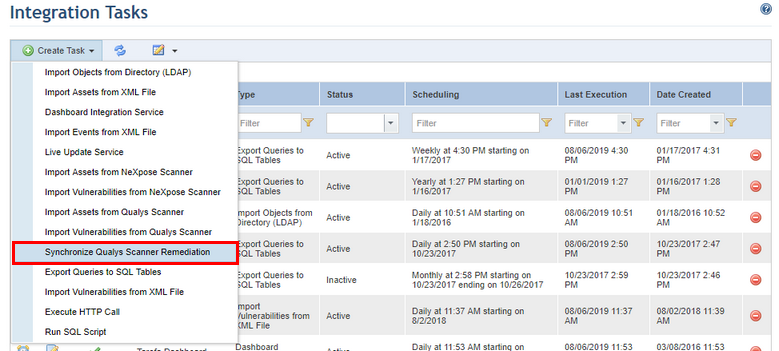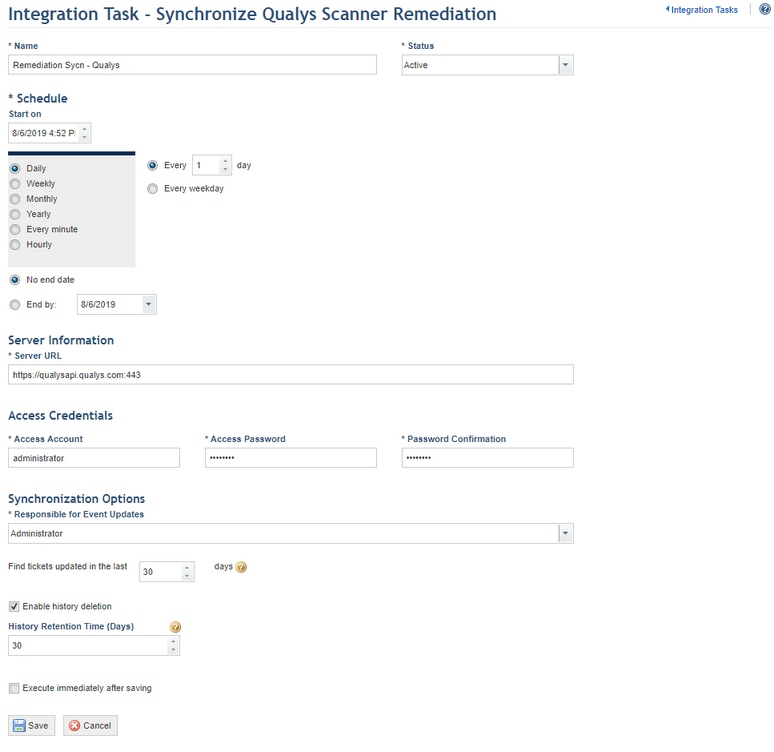
1. Access the Administration module.
2. Select Integration Tasks from the Integrations option on the menu.
3. In the Integration Tasks section, click Create Task.
4. Select the Synchronize Qualys Scanner Remediation option from the list that appears (see figure below).

The system displays the form that must be completed to create the new task (see figure below).

5. In the Name field, enter a name to identify the new integration routine.
6. In the Status field, determine the status of the new task. If you select Active, the routine will be activated immediately after it is created. If you select Inactive, the routine will be created but will not function until it is enabled.
7. You can create a schedule for the integration routine in the Schedule section. In the Start on field, enter a start date for the integration routine. Next, select one of the options (Daily, Weekly, Monthly, Yearly, Every minute, Hourly), to determine the frequency with which the task will be executed. The task can also be set to run only on week days or on weekends as well. In addition, it can be configured to have no end date by clicking the No end date option or configured to end by a certain date by completing the End by field. Note that some integration tasks may take more time to be executed than the option selected, which may result in performance problems.
8. In the Server Information section, enter the URL where the Qualys API is located under the Server URL field. This field is automatically completed but may vary depending on where your organization is located. Organizations located in Europe, for example, will need to provide the URL for the Qualys server in Europe.
9. In the Access Credentials section, valid account information must be provided to access the database in one of the QualysGuard servers. These credentials will be encrypted in the database. In the Access Account field, enter the username for the account to access the Qualys interface.
10. In the Access Password field, enter the password for the Qualys user account provided in the previous field.
11. In the Password Confirmation field, reenter the password entered in the previous field to confirm it.
12. In the Synchronization Options section, select a user who will be responsible for all event updates in the Responsible for Event Updates field. This user will appear in the history of an event’s progress as responsible for any changes made automatically through this integration task. Note that this user does not necessarily require permission to the event, nor will this user be included in any event role, such as author or event coordinator.
13. Next, specify how old tickets should be in terms of the number of days, which by default will be set to 30. This will help prevent tickets for older vulnerabilities that have already been resolved from erroneously closing or updating events for new vulnerabilities not yet resolved.
14. Mark the Enable history deletion checkbox if you want the system to automatically delete the execution history of the integration task after a certain number of days.
15. In the History Retention Time (Days) field, enter the number of days after which the history will be deleted. Note that the automatic deletion of the history deletes all of the task execution entries except for the most recent one.
16. Mark the Execute immediately after saving checkbox if you want the system to execute the task once it is saved. For subsequent executions the system follows the schedule set for the task.
17. When finished, click Save. If you want to quit the operation, click Cancel.
The system displays a success message.